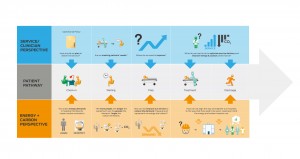Latest work: Operational risk management in energy performance contracts
Earlier this summer The Conclude Consultancy was appointed by Brighton & Sussex University Hospitals NHS Trust (BSUH) to carry out an analysis of In-use operational policies and working practices that impact energy consumption and carbon emissions across their health care estate. Conclude were appointed by the Trust because of the unique methods that they developed, known as OCCUPANCY ANALYTICS ™ and Whole Facility Energy Modelling. It is through these methods that the energy and carbon impacts of operational policies and working practices are analysed.
BSUH Assistant Director of Estates and Facilities, Mr Des Weeden said: “We are currently engaged in the planning of an Energy Performance Contract with one of the UK’s largest ESCO’s, and in that work we have identified that operational risks have the potential to negatively impact the contract. We believe that the highly innovative methods developed by Conclude will enable the Trust to effectively manage those risks. The consultancy has developed a means of holistically modelling the whole hospital operations and to directly corrleate these to the energy and carbon impacts of those operations.”
Dr Bacon adds: “The usual concern of the ESCO is that operational practices can undermine any M&E plant infrastructure improvement programme, such that the forecast benefits may not materialise. Currently ESCO’s often manage these risks through what can amount to substantial financial contingencies. However, research from Europe finds that without addressing the underlying operational causes of energy consumption, then these risks are likely to be endemic in many energy performance contracts within the health care sector. Thus the objective of our analyisis is to expose those underlying causes, and so enable the associated risks to be managed through clinical service optimisation or redesign.”
An important part of the method that Conclude has developed is a model of each ‘patient pathway.’ This is a view of the clincial pathway, but it is modelled in conjunction with the physical pathway through the functional spaces of the hospital. A temporal dimension is added to this model so that the forecast energy impacts can be analysed. Conclude has found this a particularly effective means of developing a dialogue with clinicians, so that as these pathways are investigated, the underlying energy impacts are exposed.
Tweet This

Follow us
on Twitter